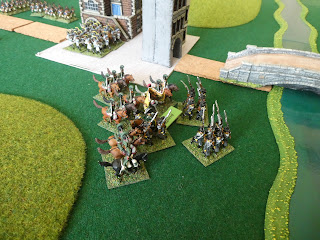The last time my Napoleonic troops were on the table was nearly 18 months ago, a long gap and mainly attributable to the COVID restrictions. When Steve and I got around to organising 'skype' games it became clear that with the avaliable cameras 15mm figures were too small to use and we therefore concentrated on our 25mm collections. However, this week, with restrictions relaxed we were able to meet up indoors again and so I dusted off the figures and set up this scenario.
It is set in the Isar valley during the 1809 Danube campaign. Rosenburg's Corps is attempting to hold the line of the Isar and cover the flank of the main Austrian army in the Danube valley to the north. Mouton's corps is marching towards Ober Bruchberg, hoping to seize the bridge and then move north. Rosenberg has chosen to use the hills on the western bank for his defensive position.
The Isar can only be crossed at the bridge or the ford, the stream flowing into the Isar can be crossed by infantry and cavalry, but artillery must use the ford. To the north and west of Klein Sandling are woods which reduce formed infantry to half speed and are impassable to cavalry. The swampy ground from which the stream flows is impassable to all troops.
Rosenberg deployed Bartenstein's infantry division on the hill to the south of Ober Bruchberg with one battalion, 1st battalion Deutschmeister, in the town itself. Mohr's infantry division was on the hill to the north of Ober Bruchberg and Frimont's infantry division was in the area beyond the stream of the Isar. Nostitz's light cavalry division was placed in reserve on the eastern bank of the Isar, able to move north or south as required. Rosenberg's plan was for Mohr to hold the hill to the north of Ober Bruchberg, Frimont to advance onto the high ground and then swing south-west to the line of the stream and threaten the flank of any enemy attack from the direction of Klein Sandling.. Nostitz was to move onto Frimont's left flank and pose a similar threat. If circumstances permitted, Bartenstein was to swing his left flank north-west to threaten the flank of any direct attack on Ober Bruchberg.
Mouton had the infantry divisions of Franquement (Wurttemburg) and Deroy (Bavaria and Baden) deployed on the line of the road south from Klein Sandling. Franquement, on the right, was to attack and seize Ober Bruchberg. Deroy was to attack Mohr's position and pin him in place. Sevdevitz's light cavalry division, which was deployed behind Franquement and Deroy, was to move south to support Franquement's right wing and threaten any infantry advancing from the hill to the south of the town. On the 'French' left, Fontanelli's Italian division was only just arriving. It was to pass to the north of Klein Sandling and attack Mohr's flank with one brigade and use the other to hold the line of the stream.
Preceded by artillery fire, the French attack moved forward. Initially good progress was made, but Mouton's divisional commanders soon began to face problems. Franquement had to move one brigade to his right as Bartenstein's leading battalions moved off the hill towards him. Sevdevitz's light cavalry took their time moving onto his flank and meanwhile a lively battle had erupted between the rival skirmisher screens.
 |
| The French left: Deroy ready to advance and Fontanelli just arriving |
 |
| The French right: the skirmisher screens come in range |
In the centre, Deroi's advance began to break up. The Bavarian brigade continued towards Mohr, but the Baden brigade halted. If they advanced further they would be threatened by Nostitz's light cavalry which was massing just beyond the stream. The plan had called for Deroy's flank to be covered by Fontanelli, but he had run into problems.
 |
| The Klein Sandling bottleneck |
The gap between Klein Sandling and the woods was narrow so Fontanelli continued to advance in column. However, Frimont had rushed forward his artillery and the columns were in effective range and suffered severe casulaties as they moved forward. The Austrian skirmishers also made a nuisance of themselves and the Italians deployed into line, slowing their advance. Encouraged, Frimont now advanced his line battalions onto the hill and then down towards the stream, flanking the Italians. The leading brigade moved left to meet this threat, slowing the advance of the second brigade which was supposed to be helping the Badeners.
 |
| Deroy's advance |
 |
| Franquement advances with cavalry support |
 |
| and are driven off |
 |
| Zach stand firm |
 |
| Frimont moves forward |
 |
| 3rd battalion Deutschmeister disintegrate |
Nearer the river, the Landwehr looked on in horror as the regular line infantry scattered and the Wurttemburg cavalry followed up in their direction. All cohesion seemed to evaporate and they were swept away by the cavalry.




















